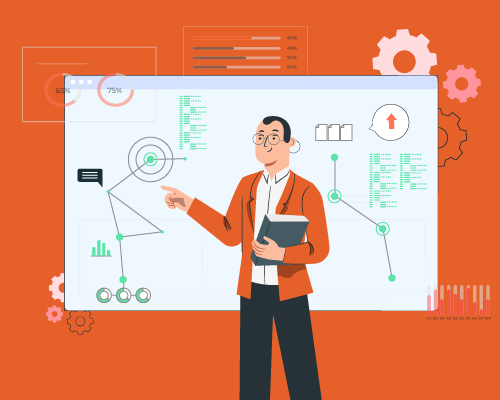Synchronous Learning Explained: Benefits, Challenges, and Best Practices

You may not know what synchronous learning is, but you’ve probably seen it before and there are multiple synchronous learning platforms you’re already using. Have you ever watched a live Instagram video where you could like or comment? If the video was teaching you something, like how to apply makeup, that’s synchronous learning. In this blog post, we are taking an in-depth look at what is synchronous learning, how it works, and more. Without waiting further, let’s dive in.
What Is Synchronous Learning?
Synchronous learning is real-time learning that happens at the same time but in different places. Early on, television was an important tool for synchronous learning.
Traditionally, synchronous learning meant learning together in person, like in a classroom. Students and teachers could interact directly. However, after the COVID-19 pandemic, synchronous learning changed significantly.
When schools closed and people worked from home, in-person synchronous learning became less common. Instead, students started interacting with teachers and other students in real time using technology like video conferencing apps, online webinars, and podcasts. Even though they weren’t in the same room, they could still do things like group discussions and team assignments.
Characteristics of Synchronous Learning
-
Real-Time Interaction
One of the best things about synchronous learning is being able to talk to your students in real time. This makes learning more personal and interesting. You can ask questions, get answers right away, and help students to understand things better. This can also make students feel like they are part of a group and work together as a team.
-
Feedback Mechanism
Your real-time feedback is a big part of teaching in a synchronous setting. Students can quickly see how well they understand the material and ask questions if they need to. By talking directly with them, you can adjust your teaching to fit their needs and make sure everyone is learning together. Remember, giving feedback isn’t just about pointing out mistakes; it’s also about encouraging good behaviour and helping students improve.
-
Engagement and Participation
Engagement is important in a synchronous learning environment. It’s not just about teaching, but also creating a space where students can interact and share ideas. Encourage students to ask questions, talk about their thoughts, and join in discussions. Use tools like polls, quizzes, and breakout rooms to keep everyone interested and involved. A classroom where students feel heard and valued is a better place to learn.
-
Social Presence
Social presence is an important part of synchronous learning that helps teachers create strong connections with their students. In a real-time classroom, you can build a sense of community and rapport. You can get to know your students individually, understand their needs, and offer personalized support. This can make learning more interesting and engaging.
-
Learning Depth
Synchronous learning is a great way to explore your topic in more detail. Unlike asynchronous learning, which can sometimes feel rushed, synchronous sessions allow for deeper discussions, critical thinking, and immediate feedback. By engaging students in interactive activities, answering questions promptly, and providing timely guidance, you can help students better understand the material. This can create more meaningful learning experiences for both you and your students.
Advantages of Synchronous Learning
-
Cost Effective
Many people assume that online or software-based training is impersonal. However, virtual instructor-led training allows instructors to maintain a personal connection with learners while eliminating the high costs of in-person training.
By using a virtual classroom tool for employee training programs, schools can save money without compromising the dynamic nature of synchronous learning. Instructors can present their content and interact with learners in real time, ensuring timely answers to questions.
Schools can also offer more real-time training activities without the added expense of travel. This means you can train more people more frequently while still saving money.
-
Teach and Train at Scale
Teaching at scale is an efficient way to save time and money. Webinars are a great option for reaching a large audience while still providing a meaningful synchronous learning experience.
You can share your course materials, like videos, presentations, and quizzes, directly during the webinar. Instead of holding multiple smaller sessions, you can cover company-wide compliance training, school orientations, and lectures in a single real-time session with hundreds or thousands of participants.
During the webinar, learners can actively engage with you and the content by asking questions and receiving answers that support their learning process.
-
Collaboration, Improved Engagement and Interactivity
Effective learning happens when teachers and students interact in real time. This helps students understand the material better and encourages them to actively participate.
Although there are different opinions about the learning pyramid, it shows that working together and being involved in group learning is important. Activities like talking about the material, practising, and teaching others can help you remember what you learn.
Virtual classrooms can make traditional classrooms even better by offering different tools for working together. Breakout Rooms help students practice and discuss, digital whiteboards make learning more interactive, and screen sharing lets students teach each other. These tools work together to create a fun and engaging learning environment.
-
Structured Learning Format
Synchronous e-learning offers a more structured approach to learning compared to asynchronous e-learning. Because students attend classes with an instructor in real-time, they’re more likely to create a schedule that guides their learning.
This structure isn’t just about having classes at a set time. It also includes other parts of the learning experience that help build a routine. For example, synchronous e-learning often involves assigning tasks or assignments to students regularly.
This helps keep students accountable, on track with assessments, and provides them with real-time feedback from their instructor. This structured learning environment is harder to achieve in asynchronous e-learning.
-
Improved Learning Outcomes
We measure the success of a class by how well our students learn. Everything we do is to help them improve.
Having a professional teacher available to guide and answer questions is the best way to help students learn. The teacher can give students immediate feedback and help them understand better. This also helps the teacher improve their teaching skills. Online classes where teachers and students can interact in real-time can help the class succeed.
Teachers can also use data from their online classroom platform to get information about things like attendance, participation in chat, recordings, and how focused students are. This data helps teachers teach in a better and more personal way, which helps students learn more.
Disadvantages Of Synchronous Learning
-
Lack of Flexibility
One of the main challenges of synchronous distance education is its limited flexibility. Everyone in the class needs to be present at the same time, using the agreed-upon technology. This can be difficult for people who prefer to learn at their own pace or who are in different time zones.
-
Students Don’t Have Control on the Training Pace
Another potential issue with synchronous distance learning is that the pace of learning is set by the teacher. While this provides structure, it can also limit certain students. Everyone in the group needs to move forward at about the same speed for the live lessons to be meaningful.
This might not be the best for students who have a lot of free time and want to learn faster than the teacher’s pace.
-
More Reliability on Technology
Technology has made it easier to learn from a distance at the same time. However, relying too much on technology can also be a problem. For example, online classes often use video conferencing, which needs a strong internet connection. If someone in the class has problems with their connection or doesn’t have fast enough internet, they might miss important information.
How Extramarks Enhances the Synchronous Learning Experience
Synchronous learning tools like Extramarks can be one of the helpful tool for teachers to improve their teaching through synchronous learning in several ways:
1. Enhanced Real-time Interaction
- Online Interactive Lessons and Live Discussions: Extramarks Smart Class Plus makes it easy for teachers to hold interactive online classes. They can share presentations, quizzes, polls, and whiteboard activities with students in real-time. Students can answer questions, join discussions, and get immediate feedback.
- Live Chat and Discussion Tools: Extramarks also provides platforms for live chat and virtual discussions. This helps students interact with the teacher and each other more actively, making learning more engaging.
2. Creating Content for Synchronous Sessions
- Pre-recorded Lessons and Explanations: Extramarks offers a collection of pre-recorded video lessons on different topics. Teachers can use these in their live classes to save time and give students a chance to review the material later.
- Interactive Learning Objects: The platform includes interactive tools like simulations, animations, and games that can make live sessions more engaging.
3. Assessment and Feedback
- Real-time Quizzes and Polls: Teachers can use online quizzes and polls during live classes to see how well students understand the material. This lets them adjust the lesson if needed.
- Personalized Feedback Tools: Extramarks might have tools to give students personalised feedback based on how they do in quizzes and activities. This can help them learn better and get more support.
Closing Thoughts
Synchronous learning offers the opportunity to connect in real-time, making education interactive and engaging. While it has its challenges, like reliance on technology and limited flexibility, the benefits often outweigh the drawbacks. With tools like Extramarks, educators can enhance the synchronous learning experience, making it more effective and enjoyable for students.
Last Updated on October 11, 2024
Reviewed by

Priya Kapoor | AVP - Academics
Priya Kapoor is an accomplished education professional with over 18 years of experience across diverse fields, including eLearning, digital and print publishing, instructional design, and content strategy. As the AVP – Academics at Extramarks, she leads academic teams in creating tailored educational solutions, ensuring alignment with varied curricula across national and international platforms...read more.









